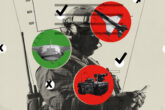May 20, 2021
More than Half the Battle
Information and Command in a New American Way of War
Executive Summary
China’s rise and Russia’s reemergence as serious military competitors to the United States during the last decade have changed the character of warfare as profoundly as the U.S. victory in the Gulf War. Precision-guided munitions and other advanced weapons systems likely will play an important role in this new era of warfare. However, to confer an advantage, these systems will require the ability to gather, transmit, process, understand, and act on information faster and with greater accuracy than an opponent. Advantage in peace and victory in war will demand a mixture of technical information systems and cognitive functions such as command decision-making. Every effort should be expended to attain an advantage by degrading adversary systems and protecting friendly systems while disrupting the enemy’s cognitive command processes and sustaining one’s own. These imperatives create a “techno-cognitive confrontation” that is continual and widespread, crossing delineations between peace and war. Within this context, great-power warfare would be far more chaotic, lethal, and contested than the conflicts of the post–Cold War period.
China and Russia have developed distinct but similar theories of victory in this new type of warfare focused on prevailing in the techno-cognitive confrontation. While their military strategies and concepts are complex and diverse, they share four critical attributes. First, they aim to keep conflicts local, limited, and therefore relatively manageable, while obviating U.S. global military preponderance. Second, they use “peacetime” information operations to (ideally) achieve their objectives without fighting or to create favorable conditions if conflict occurs. Third, they attack critical systems in space, cyberspace, and the electromagnetic spectrum, as well as physical network nodes, to achieve information degradation and command disruption, or ID/CD, against adversary systems and the cognitive processes they enable. Fourth, they increasingly are centralizing, automating, and “intelligentizing” their command and control to enable rapid, coordinated actions across multiple domains in the critical opening days of a potential conflict.
The Department of Defense' (DoD) belated response to emerging Chinese and Russian concepts has been overly technological and fixated on regaining the kind of information dominance that U.S. armed forces enjoyed from 1990 until very recently. The DoD certainly needs to develop new systems to replace its current information and command architecture, much of which dates back to the 1970s and ’80s. Still, a myopic focus on technology misses the critical cognitive and organizational aspects of the confrontation with China and Russia. The obsession with regaining information dominance is perhaps even more deleterious. Barring some wholly unforeseen event, the DoD is unlikely to regain its post–Cold War techno-cognitive dominance against China or Russia. They are too capable and too competent to allow this to happen, and the chaotic character of modern warfare vitiates against the kind of lopsided information advantage U.S. forces enjoyed against Iraq in the Gulf War.
The DoD needs to embrace, rather than fight against, the changes in the character of warfare and learn to thrive within its chaos in ways that China and Russia may be unable to match given their highly centralized and directive command-and-control structures. Instead of striving for information dominance, the DoD should seek “degradation dominance” as a way of achieving an advantage in the techno-cognitive confrontation with China and Russia. This notion attacks their theory of victory by demonstrating the ability to operate effectively enough with degraded systems in contested environments, while imposing proportional degradation on Chinese and Russian systems, thereby causing them to lose confidence in their ability to gain an insuperable advantage in the techno-cognitive confrontation.
Achieving degradation dominance against China and Russia comprises four mutually reinforcing lines of effort:
1. Force them into dilemmas about expanding or escalating a conflict by exploiting tensions between their limited-war strategies and their operational imperative to attack information and command systems aggressively at the outset of a conflict by:
- Focusing concept and capability development on limiting the effectiveness of reversible and non-kinetic attacks, particularly in space;
- Adopting a more dispersed posture for information and command systems;
- Working with allies and partners to increase multilateral cooperation in key information and command mission areas that would be high priority targets for China and Russia; and
- Forcing China or Russia into dilemmas about attacking the U.S. homeland.
2. Level the playing field in the “peacetime” information environment by:
- Gaining proper authorities for information operations in key theaters and deconflicting with other government agencies;
- Training, educating, and exercising the joint force to deal with Chinese and Russian information confrontation;
- Serving as a “systems integrator” to leverage allied and partner expertise with Chinese and Russian information operations;
- Aligning information operations with military operations to increase trust with allies, partners, and key audiences abroad; and
- Avoiding civilian casualties to stymie Chinese and Russian information operations aimed at degrading coalition cohesion.
3. Achieve degradation dominance in the techno-cognitive confrontation in space, cyberspace, and the electromagnetic spectrum by:
- Enabling people and building trust across command echelons and organizations, as well as with critical systems;
- Adopting policies and demonstrating capabilities to proportionally attack sensitive Chinese and Russian information and command systems;
- Training to fight with degraded information and disrupted command;
- Developing the ability to operate with “loose” decentralized peer-to-peer command, control, and communications structures in degraded, disrupted, or contested environments;
- Developing and deploying a “Rosetta Stone” communications architecture that enables resilient multi-path networks through translation, rather than interoperability;
- Employing mission command and other forms of decentralized and delegated command philosophies, particularly when command systems are disrupted;
- Accepting “good enough” targeting against low-value targets in contested environments;
- Adopting rapid targeting processes for high-tempo, degraded operations in contested environments;
- Leveraging artificial intelligence, sophisticated automation, and bounded autonomy to reduce cognitive loads and accelerate decision-making; and
- Using military deception to foil adversary planning and targeting, particularly automated, artificially intelligent, or other algorithmically enhanced systems.
4. Organize and train for degraded and disrupted multi-domain operations:
- Put the “combat” back in the Geographic Combatant Commands by refocusing them on warfighting vice military diplomacy;
- Create standing, multi-domain units across multiple echelons of command down to the tactical level;
- Increase regular joint and multi-domain training and Combatant Commanders Exercise Engagement and Training Transformation (CE2T2) funds; and
- Use live, virtual, and synthetic training to train realistically in all domains.
Enacting these recommendations would mark a major change in the DoD’s mindset about the future of warfare and the role of information and command in competition and conflict. Letting go of notions of dominance to strive instead for operating effectively enough while degraded is a difficult, but needed, paradigm shift given the challenges posed by China and Russia and the changing character of modern warfare. The alternative likely would be a ruinously expensive and fruitless search for symmetrical “overmatch.”
Though daunting, the DoD has successfully embarked on similar paradigm-shifting reform efforts in the past. The most relevant was the post-Vietnam initiative to address the persistent weakness of U.S. night-fighting capabilities. By becoming, arguably, the world’s most effective night-fighting force, the DoD presented adversaries with a vexing dilemma: fight during the day and face the wrath of U.S. airpower and firepower, or fight at night at perhaps an even worse disadvantage.
Achieving degradation dominance through these lines of effort would pose a similar dilemma to Chinese and Russian forces in the event of a crisis or conflict. They would have to consider attacking U.S. information and command capabilities, albeit with diminishing confidence that such attacks would render U.S. forces incapable of responding. At the same time, their aggression would risk escalating or expanding a conflict and open up their own information and command systems to proportional U.S. responses. Alternatively, they could opt not to attack, or limit their attacks to reduce the risk of escalation, but these approaches would leave U.S. information and command systems relatively unscathed. Either option would leave them with a less than satisfactory outcome, and maintaining that pessimistic assessment is key to deterring aggression; defending U.S. allies, partners, and vital interests; and upholding a free and open international order in East Asia and eastern Europe.
Download the full report.
More from CNAS
-
Defense / Technology & National Security
Safe and EffectiveThe promise of artificial intelligence (AI) and autonomy to change the character of war inches closer to reality...
By Josh Wallin
-
America’s Eroding Airpower
To have a chance at success, the United States would need more low-end drones and missiles that can provide it with mass....
By Stacie Pettyjohn
-
Build Allied AI or Risk Fighting Alone
Amid the hype about artificial intelligence (AI) and autonomous systems, militaries around the world are developing, experimenting with, and integrating these tools into every...
By Becca Wasser & Josh Wallin
-
The Evolution of Drones with Stacie Pettyjohn, Center for a New American Security
Stacie Pettyjohn, Senior Fellow and Director of the Defense Program at the Center for a New American Security, joins Squaring the Circle to discuss the evolution of drones. ...
By Stacie Pettyjohn





